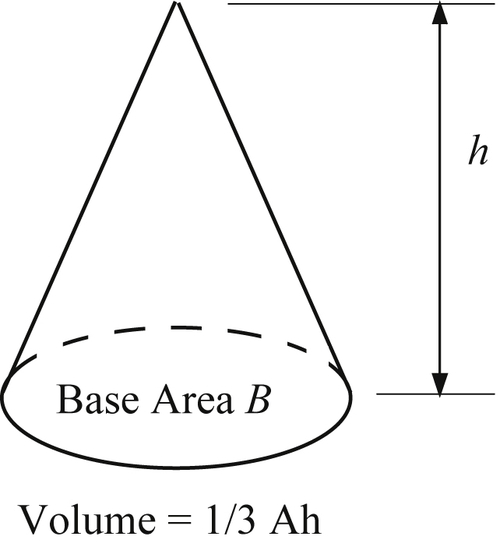Questions and Exercises
1. In the design space, plot the objective function contours for the following unconstrained problem and identify the Pareto optimal set:
Minimize: f1(x) = (x1 − 2)2 + (x2 − 3)2
f2(x) = (x1 − 5)2 + (x2 − 8)2
Draw the gradients of each function at any point on the Pareto optimal set in the design space. Comment on the relationship between the two gradients.
2. Sketch the Pareto optimal set for Problem 1 in the criterion space. Find the utopia point. Is the utopia point attainable?
3. A constrained optimization of two variables and two objectives is given below:
Minimize: f1(x) = (x1 − 2)2 + (x2 − 3)2
f2(x) = (x1 − 5)2 + (x2 − 8)2
Subject to: g1 = −x1 − x2 + 10 ≤ 0
g2 = −10 − 2x1 + 3x2 ≤ 0
b. Write a MATALB script to find the Pareto front in the criterion space using the generative method. Graph the feasible and infeasible regions and identify the Pareto front in the criterion space.
4. A right circular cone shown below is considered for a redesign. The objective is to use a minimum material (surface area) to achieve a maximum volume. More specifically, we want to minimize both the lateral area S and total surface area T of the cone for a volume no less than 250 cm3 by varying the base radius r and height h of the cone. Note that T = S + B, in which B is the based area B = πr2. The size of the cone is constrained by r ∈ (1, 10) cm and h ∈ (1, 20) cm.

a. Formulate a MOO problem for the cone design mathematically.
b. Sketch the objective contours and constraint functions in the design space and identify a feasible set S and the Pareto optimal set.
c. Solve the respective single-objective optimization problems to find the utopia point. Comment on the design of the cone at the utopia point.
d. Sketch the Pareto front in the criterion space using the generative method. Graph the feasible and infeasible regions and identify the Pareto front in the criterion space.
5. Solve Problem 4 using the weighted-sum method. Find at least 10 solutions by varying the weights (including a case for w1 = 0.1 and w2 = 0.9). Identify those solutions in the Pareto front in the criterion space.
6. Solve Problem 4 using the weighted min–max method, assuming w1 = 0.1 and w2 = 0.9. Compare results with those of Problem 5. Comment on the pros and cons of the weighted min–max and the weighted-sum method based on the observation made in solving the cone problem.
7. Solve Problem 4 using the NBI methods by creating at least five points on the CHIM.
8. Solve Problem 3 using the min–max method.
10. Solve Problem 4 using the NSGA II of the genetic algorithm. Follow the discussion in Section 5.3.5.3 to download the MATLAB code and write two MATLAB files for the cone design problem. Use population size = 200 and number of generations = 500.
11. Solve Problem 4 using NIMBUS software online. Comment on the advantages and disadvantages of the software from a user's perspective.
..................Content has been hidden....................
You can't read the all page of ebook, please click here login for view all page.
